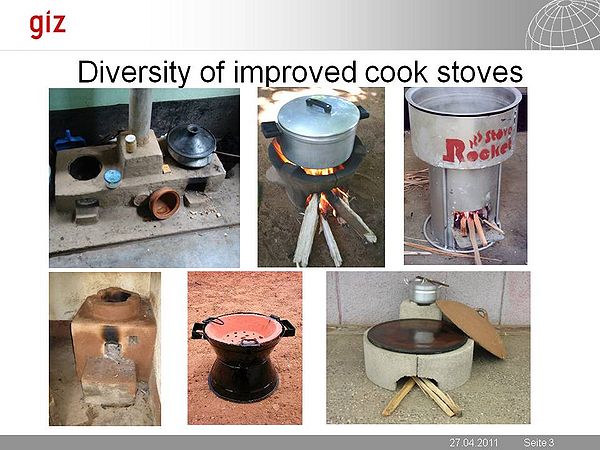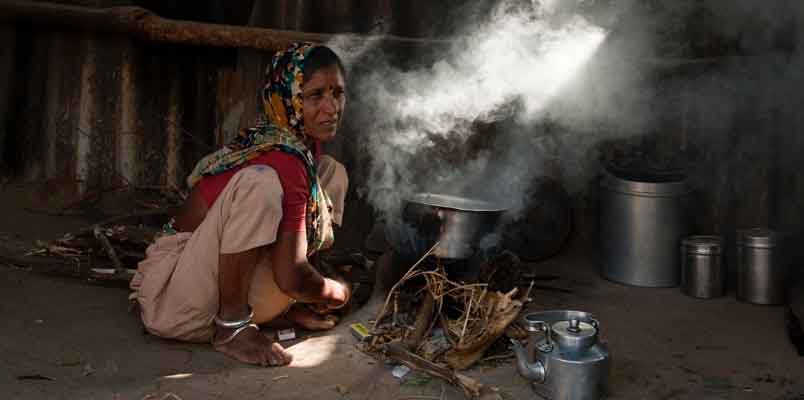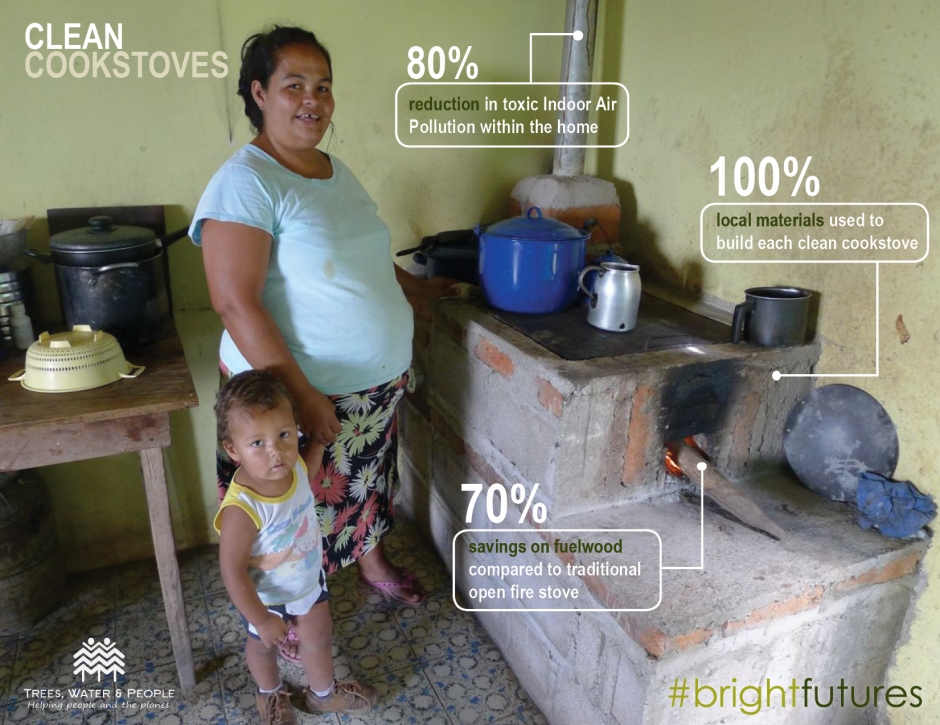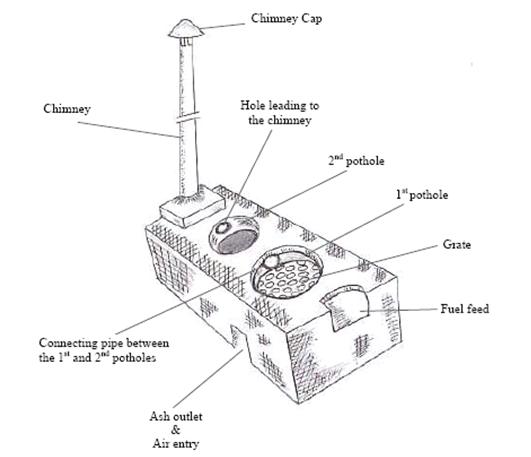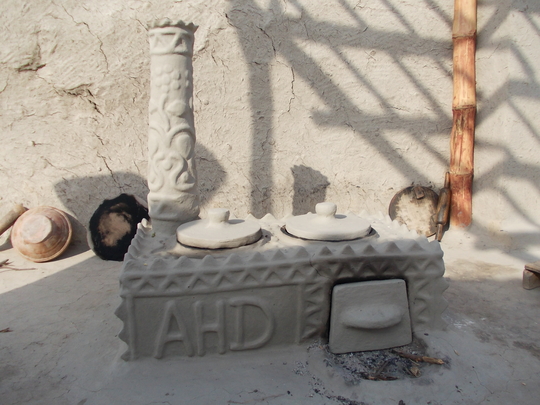Improved Cook Stoves: Solution to the Indoor Air Pollution in Developing Countries
FINAL Submission of TSM 311 Research Paper
Proposal by Karittha Liewchanpatana
The practice of using cook stoves has been with civilization ever since mankind was able to tame fire. Despite often wild rampages of forest fires or the misappropriate use of the element, fire has brought humanity many benefits. Cooking food does not only make food easier to digest, but it also aids in preserving shelf-life and nutritional quality. Furthermore, with the invention of cook stoves, humans were able to cook food indoors and craft a wide variety of delicious cuisine as a result. For many developed countries such as the United States, the majority of people do not require traditional cook stoves, which utilize biomass fuels such as charcoal and firewood, to cook most of their food. With the availability and affordability of gas and electricity, people in the developed countries are able to enjoy the convenience of these luxuries. In comparison, many people in the developing countries struggle to cook their food in the traditional stoves while battling against the indoor air pollution (IAP) and the respiratory and health problems that are associated with IAP. As Jean Anthelme Brillat-Savarin, a famous food philosopher, once said, “The future of nations will depend on how they feed themselves” (King, 2012). Like Brillat-Savarin, the author believes that how one cooks and handles food can determine the fate of humanity in developing countries and possibly even offer a solution to the urgent problems of today. In a 21st century, globalized world, everyone should have access to efficient and safe cook stoves because an improved cook stove is the solution to the indoor air pollution problem. Currently, the prevalence of indoor air pollution (IAP), due to use of biomass fuel and the inefficient cooking stoves, poses serious health and environmental threats to developing countries.
Causes of Indoor Air Pollution
About half of the 7-billion world population and approximately 90% of the developing countries depend largely on the unprocessed biomass fuels, such as wood and crop residues for cooking and heating processes (Bruce, N., et al., 2000). With the dependence on biomass and coal fuels, it is no surprise that these fuels along with the inefficient cook stoves are the roots to the urgent problem of IAP. Studies have shown that a strong causal relationship exists between the use of biomass fuels and IAP, clearly demonstrating that long exposure to smoke from combustion of wood and charcoal are the direct cause of IAP (Smith, 2000 & Taylor, 2012). As these fuels burn, they produce pollutants and poisonous fumes that are harmful to humans’ health as they inhale them. In many developing countries, the indoor air quality fell severely below the National Ambient Air Quality Standards (NAAQS) set up by the US Environmental Protection Agency. One of the six principle pollutants that the NAAQS measures includes particulate matter (PM), which is also known as particulate pollution. The particulate matter comprises of a variety of components such as sulfates and nitrates acids, organic chemicals, metals, and soil or dust particles (Lippmann, 1998).
According to the United States Environmental Protection Agency, the 24-hour guidelines for PM of 2.5 micrometers (PM2.5 ) is 12 micrograms per cubic meter of air (μg/m3 ) while the PM of 10 micrometers (PM10 ) restrict to a higher percentile of 150 μg/m3 (Lippmann,1998). These two categories of PM present a great concern due to their small sizes, enabling them to penetrate deeply into the lungs and causing serious health implications. In most of the developing countries, the indoor concentration of particulate matters far exceeds the acceptable guidelines and frequently reach up to the hazardous range of 30,000 (μg/m3 ) (Bruce, N., et al., 2000). An air quality analysis conducted in China revealed that the mean concentration for burning coal and wood is at 24,400 μg/m3 , which is a hundred times higher than the established standard (Zhang & Smith, 2007). Thus, these findings indicate that the level of IAP, which is due to incomplete combustion of biomass, surpasses the government-controlled standards.
In addition to the biomass fuels, the use of inefficient traditional cook stoves is also one of the main culprits of IAP. Most households in the developing countries typically cook in an open fire with a simple arrangement such as a three-rock set-up, a “U-shaped hole in a block of clay or a pit in the ground”, or in “poorly functioning earth or metal stoves” (Bruce, N., et al., 2000). In these arrangements, the thermal efficiency of the biomass fuels, such as firewood, is about 5-10% (Maes, et al., 2012). These types of inefficient cook stoves hardly support any complete combustion due to the low combustion efficiency and low heat transfer to the pot (Kees & Feldmann, 2011). As a result of the incomplete combustion, a high concentration of toxic fumes and particulate matter (PM) is produced (Smith, et al., 2004), which contributes to the high level of IAP.
Consequences
Statistics support the notion that indoor air pollution (IAP) is one of the most serious byproducts of the biomass fuels and the inefficient cook stoves. In 2012, the World Health Organization reported that IAP is the causal agent that is responsible for the 4.3 million deaths in the low and middle income (LMI) countries. The heaviest burden of the high mortality rate lies in the nations of the South East Asia and Western Pacific regions with 1.69 and 1.62 million deaths, respectively. In Africa, 600,000 deaths from IAP were documented while 200,000 occurred in the Eastern Mediterranean region. There were 99,000 deaths reported in Europe and 81,000 in the Americas. The remaining 19,000 deaths were distributed across high income countries.
The death tolls are mainly accredited to the work of respiratory diseases such as acute lower respiratory infection (ALRI) and chronic obstructive pulmonary disease (COPD) (WHO, 2012). As people inhale the fine smoke particles produced by the biomass fuels, they obstruct airways and cause the lining of the bronchial tubes to be inflamed. It is difficult for people to realize that they have breathed in these tiny particles as the particles are invisible to the naked eye, with a size less than 10 microns (Bruce, N., et al., 2000). ALRI is also the primary culprit for the high mortality rate of children under 5 years old in the developing countries (Bruce, N., et al., 2000). These children are two to three times more likely to contract ALRI (Warwick & Doig, 2004). As a result, the number of child mortality constitutes 2 million annually. Due to long exposure to the cooking smoke, women and children who spend most of the time at home, particularly in the kitchen, are most susceptible to these health problems. As toddlers and infants are usually carried on their mothers’ backs while cooking, they are especially vulnerable to IAP and the smoke (WHO, 2005). In addition to the tiny particles, the smoke also contains toxic fumes, such as carbon monoxide, carcinogens such as bezene, formaldehyde, and sulphur dioxide (Bruce, N., et al., 2000). Evidence also illustrates that IAP is attributed to causing asthma, respiratory infections, lung cancer, cataract, low birth weight and increase in perinatal deaths.
In addition to the health problems that IAP produces, its consequences also take a heavy toll on the environment. In Africa, 90% of wood derived from deforestation is used for energy (FAO, 2010). Likewise in China, more than 60% of the population are from rural areas whereby most people use biomass fuels and coal fuels (Zhang & Smith, 2007). The use of biomass fuels accounts to 80% of the rural energy consumption in China while 10% is from the coal fuels. Similarly, in India, more than 72% of the households are found to be using unprocessed biomass fuels (Dukka, et al., 2007). With the extensive use and demand for the cheap biomass and coal fuels, forests are felled at an expeditious rate to accommodate the needs of the developing countries. In 2010, the Food and Agriculture Organization (FAO) of the United Nations surmised that nearly 13 million hectares of forest are lost each year. Furthermore, as a result of inefficient cooking, 1 billion tons of CO2 is produced annually (Environfit International). The detrimental effects of deforestation range from soil erosion, loss of arable land, and extinction of flora and fauna to aggravation of global warming and irregular climate changes. With the increased frequency of landslides from soil erosion and unfavorable farming conditions due to extreme climate changes, people would experience even more hardships. Therefore, the escape from the cycle of poverty would be remotely possible given that people are relying heavily on biomass and coal fuels.
Solution to Indoor Air Pollution
Therefore, to combat the critical and pressing problems of IAP, various solutions and policies have been proposed. One that garners much scientific support is the development of improved cook stoves. Many scientific institutions and international organizations around the world such as the United Nations, the German Technical Cooperation Agency (GTZ) and The Global Alliance for Clean Cookstoves strongly supported and urged for a production and dissemination of an improved cook stove (ICS) in the developing countries (Kees & Feldmann, 2011). According to the WHO and UN Development Programme, an ICS is defined as a closed stove with a chimney or an open fire with a hood (Renewable Energy Policy Network for the 21st Century, 2010). In 2010, there are 830 million people around the world who used an ICS with the largest number of ICS adoptions in China (REN21, 2010). As part of the UN Millennium Development Goals, the UN Millenium Project aims to “reduce the number of people without effective access to modern cooking fuels by 50 percent and make improved cook stoves widely available by 2015” (UN Millennium Project, 2005). Currently, there are many types of ICSs produced, which range from “artisanal or semi-industrially produced clay and metal wood-fuel stoves to solar cookers, heat retainers as well as cookers using plant oil, ethanol or biogas” (Kees & Feldmann, 2011). Given the high cost of cleaner fuels (i.e. liquid petroleum gas, ethanol and biogas), it is highly improbable that households in developing countries would abandon biomass fuels as their main source of energy for the cleaner fuels (Dutta, 2007). Hence, among ICSs that were developed, those which deployed the use of biomass fuels are more widely used by most households.
The reasons why a biomass ICS is the solution to the urgent problem of IAP lie in its functionality. Made of durable materials, nearly all biomass improved cook stoves will last for 5 to 10 years or longer (REN21, 2010). Despite the variety of designs of ICSs, they follow a common set of primary technical factors, which includes an optimization of heat transfer to the pot and an improvement of combustion efficiency of biomass fuels (Kees & Feldmann, 2011). Heat transfer efficiency refers to “how much of the heat is absorbed by the pot” whereas combustion efficiency is characterized by “how much of the energy and carbon in the fuel is converted to heat and carbon dioxide” (Venkataraman, et al., 2010). These two principles are important in reducing IAP as they significantly reduce the biomass fuel requirement as well as the concentration of harmful particulate matters. With a higher heat transfer compared to the traditional cook stoves, less amounts of fuels are required for cooking (Kees & Feldmann, 2011). Likewise, as a biomass ICS allows for a higher percentage of complete combustion, less quantity of harmful particulate matters is produced.
Countless studies in various Asian and African countries, where biomass ICSs are promoted and distributed, have shown a considerable decline in IAP concentration. In India, where a sukhad (an ICS with a chimney-stove design) was disseminated, the concentration of these hazardous particulate matters decrease by 44% for PM2.5 and 70% for CO (Bruce, N.G., et al., 2011). On the other hand, similar reports in reduction of particulate matter concentration are found in Latin America. In Guatemala, there is a decrease of PM by 90% with the use and maintenance of a plancha improved stove, which is made of cement blocks, with a metal and flute (Bruce, N.G., et al., 2011). As a result of ICSs, there was considerable increase of improvement in indoor air quality. Not only did the level of IAP reduce, personal exposure to these harmful matters also decreased. With the development of additional hoods with flues to the improved ceramic stoves in Kenyan Massai households, the percentage of women’s exposure to CO went down by 35% along with a 75% decrease of 24h mean kitchen PM2.5 and CO (Bruce, N.G., et al., 2011). As mothers and their children spend most of their time in the kitchen, the exposure to the harmful gases and particulate matters produced from biomass combustion is unavoidable. However, with the use of an ICS, the risk to exposure of IAP is cut down and kept to the minimal as much as possible.
Moreover, a biomass ICS is especially beneficial for poor households in the developing countries where there is a lack of common and basic health-care infrastructures. In these rural areas, the high cost of treatments for these respiratory diseases make it impossible for people to seek any medical attention. Many health benefits are found with the use of an ICS, such as the reduction in acute lower respiratory infection (ALRI) among children. With fewer emission of PM through the increase of efficiency in complete combustion, lesser amounts of fine dust particles would enter the lungs. This reduces the chance of individuals developing respiratory diseases. In regards to ALRI, an assessment of child exposure to IAP in Guatemala revealed that the pneumonia incidence with hypoxemia (low oxygen saturation) among children (under 18-months old) decrease by approximately 30% (Bruce, N.G., et al., 2011). Among women and men above 30 years old, a reduction in chronic obstructive pulmonary disease (COPD) and lung cancer was reported with the use of an ICS. Thus, as the morbidity of these respiratory diseases and the mortality of children reduces, both the government and individuals can cut down their spending on health-care treatment and hospitalization fees.
On top of the reduction of IAP and respiratory diseases, there is also a benefit of time-saving brought by a biomass ICS to many households. Compared to traditional cook stoves, an ICS reduces cooking time by 25% as an increase of heat-transfer and combustion efficiency means that food require less time to cook. Furthermore, an ICS saves up to 60% reduction in biomass and charcoal requirement (Environfit International).With a lesser amount of biomass fuel needed, this translates into more time being saved from fuel collection. As the duties of fuel collection often fall on the shoulders of the women in the developing countries, a biomass ICS frees up to 50% more time for women to engage in other productive activities, such as child care, social community activities and income generation (Habernehl, 2007). Additionally, there are local and global environmental gains due to the reduction in global warming gases from the adoption of ICSs. A cost-benefit analysis study by the WHO asserted that the value of CO2 reduction from the use of ICSs is approximately US$680 million per year (Hutton, et al., 2006). Also, the percentage of CO2 is estimated to reduce by 25-50% from the implementation of a biomass ICS (Cookstoves, 2011). As biomass fuels are burned more efficiently in an ICS, the complete combustion releases less amount of gases, such as methane and nitrous oxide. These gases have a high global warming potential and can remain longer in the atmosphere (Cookstoves, 2011).
Within the last 30 years, the most successful implementation plan of ICSs is the National Improved Stove Program (NISP) in China that aims to equip households in rural communities with more efficient biomass stoves for cooking and heating. The program was run by the Ministry of Agriculture (MOA) with a budget of US$1.4 million annually along with an additional US$17.9 million from the local government (Sinton, et al., 2004). With 200 million ICSs installed in rural China, NISP was able to achieve a success in its dissemination program due to an increasing purchasing power and a commercialization strategy (Sinton, et al., 2004). The program organized stove competitions among counties that encouraged nationwide participation and attracted media attention and publicity. Evaluations from various studies found that the main features that contributed to the widespread achievement of NISP include:
Decentralization of administration … that provided subsidies to rural energy enterprise development, and quality control through central production of critical components (such as combustion chamber parts) and engaging local technical institution in modifying national stove design to local needs… [with] financial payment provided to local counties only after an independent review of their achievement (Bruce, N.G., et al., 2011).
Even though NISP did not manage to bring down the overall concentration of IAP and particulate matters below the acceptable range of the Chinese national indoor air standards and the WHO air quality guidelines (AQGs), the installation of ICSs was able to reduce IAP concentration by a remarkable quantity. Thus, this illustrates that continuous and long-term effort is required for further IAP reduction.
While there are millions of ICSs distributed to households in many developing countries, there are still various barriers that prevent long-term and global-scale dissemination of ICSs. Despite the effectiveness of ICSs, several factors remain an obstacle for adoption among poor households. The challenge of understanding the local needs and the context is a critical consideration for both the government and organizations in order to carry out a successful ICS plan. Studies showed that the technologies needed for development of ICSs were too costly for poor households while many social marketing strategies failed to convince the locals of the benefits of an ICS. As the use of ICSs is intended for rural communities, most people are from lower socioeconomic backgrounds (Bhojvaid, et al., 2014). Hence, despite the promise of ICS benefits, many households are reluctant to make the initial investment. Thus, public investment from national governments and donor organizations is crucial in setting up a market for ICSs and providing financial subsidies. As there is a lack of knowledge and awareness of the importance of ICSs, it is crucial for both governments and donor organizations to promote awareness campaigns and support the development of ICS technologies and research centers. Hence, the roles of both governments and donor organizations are fully needed to address these challenges before carrying a wide-scale launch of an ICS plan.
In conclusion, Indoor Air Pollution (IAP) is an urgent problem that presents immediate health and environmental threats to humanity. Not only does IAP cause fatal respiratory diseases, such as acute lower respiratory infection (ALRI) and chronic obstructive pulmonary disease (COPD), and a high mortality rate of millions among children and adults, it also harms the environment to a remarkable extent. To address these concerns and reduce the concentration of IAP as well as mitigate the adverse impacts produced by IAP, the solution lies in the development and dissemination of a biomass improved cook stove (ICS). As a biomass ICS is able to reduce the concentration of particulate matters and hazardous gases as well as bring down the morbidity rate of respiratory morbidity, it is important for rural households to have access to an ICS. These ICSs are beneficial for developing countries because most people generally cannot afford the high cost of health treatments from respiratory diseases and live in areas that often lack basic health care. Even though there are successful ICS dissemination programs around the world, much work and contribution from both the governments and donor organizations are still required to ensure that all households in developing countries utilize clean and safe cook stoves for daily food preparation.
References
Bhojvaid, V., Jeuland, M., Kar, A., Lewis, J. J., Pattanayak, S. K., Ramanathan, N,. & Rehman, I. H. (2014). How do people in rural India perceive improved stoves and clean fuel? Evidence from Uttar Pradesh and Uttarakhand. International journal of environmental research and public health, 11(2), 1341-1358.
Bruce, N., Perez-Padilla, R., & Albalak, R. (2000). Indoor air pollution in developing countries:a major environmental and public health challenge. Bulletin of the World Health Organization, 78(9), 1078-1092.
Bruce, N.G., Rehfuess, E.A., Smith, K.R. (2011) Household energy solutions in developing countries. J.O. Nriagu (Ed.), Encyclopedia of Environmental Health (pp. 62–74). Burlington, WA: Elsevier.
Cookstoves, H. (2011). Environment, Health, and Climate Change: A New Look at an Old Problem.
Dutta, K., Shields, K. N., Edwards, R., & Smith, K. R. (2007). Impact of improved biomass cookstoves on indoor air quality near Pune, India. Energy for Sustainable Development, 11(2), 19-32.
Environfit International (n.d.) Our Impact. Retrieved from http://www.envirofit.org/impact/?sub=impact
FAO. (2010). Global Forest Resources Assessment 2010 Main Report. FAO.
Habermehl, H. (2007). Economic evaluation of the improved household cooking stove dissemination programme in Uganda. German Development Cooperation (GTZ).
Hutton, G., Rehfuess, E., Tediosi, F., & Weiss, S. (2006). Evaluation of the costs and benefits of household energy and health interventions at global and regional levels. In Evaluation of the costs and benefits of household energy and health interventions at global and regional levels. OMS.
Kees, M., & Feldmann, L. (2011). The role of donor organisations in promoting energy efficient cook stoves. Energy Policy, 39(12), 7595-7599.
King, J. (2012). Food and the city : urban agriculture and the new food revolution. Amherst, N.Y: Prometheus Books.
Lippmann, M. O. R. T. O. N. (1998). The 1997 US EPA standards for particulate matter and ozone. Issues in environmental science and technology, 10, 75-100.
Maes, W. H., & Verbist, B. (2012). Increasing the sustainability of household cooking in developing countries: policy implications. Renewable and Sustainable Energy Reviews, 16(6), 4204-4221.
Renewable Energy Policy Network for the 21st Century (2010). REN21 Renewables 2010 global status report. Retrieved from http://www.ren21.net/Portals/0/documents/activities/gsr/REN21_GSR_2010_full_revised%20Sept2010.pdf
Sinton, J. E., Smith, K. R., Peabody, J. W., Yaping, L., Xiliang, Z., Edwards, R., & Quan, G. (2004). An assessment of programs to promote improved household stoves in China. Energy for Sustainable Development, 8(3), 33-52.
Smith, K. R., Mehta, S., & Maeusezahl-Feuz, M. (2004). Indoor air pollution from household use of solid fuels. Comparative quantification of health risks: global and regional burden of disease attributable to selected major risk factors,2, 1435-93.
Smith, K. R., Samet, J. M., Romieu, I., & Bruce, N. (2000). Indoor air pollution in developing countries and acute lower respiratory infections in children. Thorax, 55(6), 518-532.
Taylor, E. T., & Nakai, S. (2012). Prevalence of acute respiratory infections in women and children in western Sierra Leone due to smoke from wood and charcoal stoves. International journal of environmental research and public health, 9(6), 2252-2265.
UN Millennium Project (2005). Investing in Development: A Practical Plan to Achieve the Millennium Development Goals. Retrieved from http://www.unmillenniumproject.org/documents/MainReportComplete-lowres.pdf
Venkataraman, C., Sagar, A. D., Habib, G., Lam, N., & Smith, K. R. (2010). The Indian national \initiative for advanced biomass cookstoves: the benefits of clean combustion. Energy for Sustainable Development, 14(2), 63-72.
Warwick, H., & Doig, A. (2004). Smoke–the Killer in the Kitchen. International Technology Development Group (ITDG).[http://www. itdg. org/html/smoke/sm oke_report_1. htm].
World Health Organization. (2014). Global burden of disease due to household air pollution 2012. Retrieved from http http://www.who.int/phe/health_topics/outdoorair/databases/FINAL_HAP_AAP_BoD_24March2014.pdf?ua=1
World Health Organization. (2005). The World health report: 2005: make every mother and child count. Retrieved from http://www.who.int/whr/2005/whr2005_en.pdf
Zhang, J. J., & Smith, K. R. (2007). Household air pollution from coal and biomass fuels in China: measurements, health impacts, and interventions.Environmental Health Perspectives, 115(6), 848.

